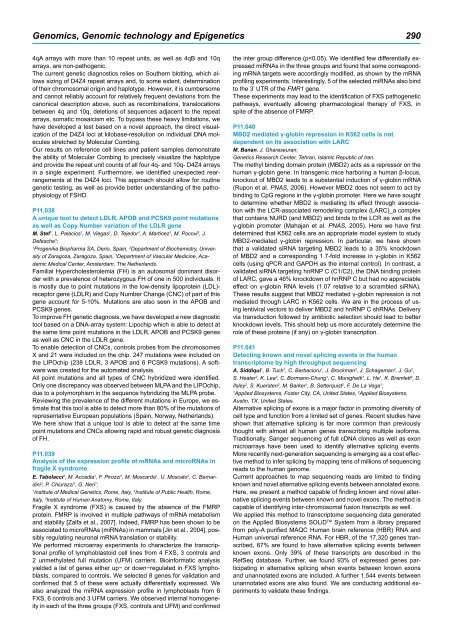2009 Vienna - European Society of Human Genetics
2009 Vienna - European Society of Human Genetics
2009 Vienna - European Society of Human Genetics
Create successful ePaper yourself
Turn your PDF publications into a flip-book with our unique Google optimized e-Paper software.
Genomics, Genomic technology and Epigenetics<br />
4qA arrays with more than 10 repeat units, as well as 4qB and 10q<br />
arrays, are non-pathogenic.<br />
The current genetic diagnostics relies on Southern blotting, which allows<br />
sizing <strong>of</strong> D4Z4 repeat arrays and, to some extent, determination<br />
<strong>of</strong> their chromosomal origin and haplotype. However, it is cumbersome<br />
and cannot reliably account for relatively frequent deviations from the<br />
canonical description above, such as recombinations, translocations<br />
between 4q and 10q, deletions <strong>of</strong> sequences adjacent to the repeat<br />
arrays, somatic mosaicism etc. To bypass these heavy limitations, we<br />
have developed a test based on a novel approach, the direct visualization<br />
<strong>of</strong> the D4Z4 loci at kilobase-resolution on individual DNA molecules<br />
stretched by Molecular Combing.<br />
Our results on reference cell lines and patient samples demonstrate<br />
the ability <strong>of</strong> Molecular Combing to precisely visualize the haplotype<br />
and provide the repeat unit counts <strong>of</strong> all four 4q- and 10q- D4Z4 arrays<br />
in a single experiment. Furthermore, we identified unexpected rearrangements<br />
at the D4Z4 loci. This approach should allow for routine<br />
genetic testing, as well as provide better understanding <strong>of</strong> the pathophysiology<br />
<strong>of</strong> FSHD.<br />
P11.038<br />
A unique tool to detect LDLR, APOB and PcsK9 point mutations<br />
as well as copy Number variation <strong>of</strong> the LDLR gene<br />
M. Stef 1 , L. Palacios 1 , M. Viegas 1 , D. Tejedor 1 , A. Martinez 1 , M. Pocovi 2 , J.<br />
Defesche 3 ;<br />
1 Progenika Biopharma SA, Derio, Spain, 2 Department <strong>of</strong> Biochemistry, University<br />
<strong>of</strong> Zaragoza, Zaragoza, Spain, 3 Department <strong>of</strong> Vascular Medicine, Academic<br />
Medical Center, Amsterdam, The Netherlands.<br />
Familial Hypercholesterolemia (FH) is an autosomal dominant disorder<br />
with a prevalence <strong>of</strong> heterozygous FH <strong>of</strong> one in 500 individuals. It<br />
is mostly due to point mutations in the low-density lipoprotein (LDL)receptor<br />
gene (LDLR) and Copy Number Change (CNC) <strong>of</strong> part <strong>of</strong> this<br />
gene account for 5-10%. Mutations are also seen in the APOB and<br />
PCSK9 genes.<br />
To improve FH genetic diagnosis, we have developed a new diagnostic<br />
tool based on a DNA-array system: Lipochip which is able to detect at<br />
the same time point mutations in the LDLR, APOB and PCSK9 genes<br />
as well as CNC in the LDLR gene.<br />
To enable detection <strong>of</strong> CNCs, controls probes from the chromosomes<br />
X and 21 were included on the chip. 247 mutations were included on<br />
the LIPOchip (238 LDLR, 3 APOB and 6 PCSK9 mutations). A s<strong>of</strong>tware<br />
was created for the automated analysis.<br />
All point mutations and all types <strong>of</strong> CNC hybridized were identified.<br />
Only one discrepancy was observed between MLPA and the LIPOchip,<br />
due to a polymorphism in the sequence hybridizing the MLPA probe.<br />
Reviewing the prevalence <strong>of</strong> the different mutations in Europe, we estimate<br />
that this tool is able to detect more than 80% <strong>of</strong> the mutations <strong>of</strong><br />
representative <strong>European</strong> populations (Spain, Norway, Netherlands).<br />
We here show that a unique tool is able to detect at the same time<br />
point mutations and CNCs allowing rapid and robust genetic diagnosis<br />
<strong>of</strong> FH.<br />
P11.039<br />
Analysis <strong>of</strong> the expression pr<strong>of</strong>ile <strong>of</strong> mRNAs and microRNAs in<br />
fragile X syndrome.<br />
E. Tabolacci1 , M. Accadia1 , F. Pirozzi1 , M. Moscarda1 , U. Moscato2 , C. Bernardini3<br />
, P. Chiurazzi1 , G. Neri1 ;<br />
1 2 Institute <strong>of</strong> Medical <strong>Genetics</strong>, Rome, Italy, Institute <strong>of</strong> Public Health, Rome,<br />
Italy, 3Institute <strong>of</strong> <strong>Human</strong> Anatomy, Rome, Italy.<br />
Fragile X syndrome (FXS) is caused by the absence <strong>of</strong> the FMRP<br />
protein. FMRP is involved in multiple pathways <strong>of</strong> mRNA metabolism<br />
and stability [Zalfa et al., 2007]. Indeed, FMRP has been shown to be<br />
associated to microRNAs (miRNAs) in mammals [Jin et al., 2004], possibly<br />
regulating neuronal mRNA translation or stability.<br />
We performed microarray experiments to characterize the transcriptional<br />
pr<strong>of</strong>ile <strong>of</strong> lymphoblastoid cell lines from 4 FXS, 3 controls and<br />
2 unmethylated full mutation (UFM) carriers. Bioinformatic analysis<br />
yielded a list <strong>of</strong> genes either up− or down−regulated in FXS lymphoblasts,<br />
compared to controls. We selected 8 genes for validation and<br />
confirmed that 5 <strong>of</strong> these were actually differentially expressed. We<br />
also analyzed the miRNA expression pr<strong>of</strong>ile in lymphoblasts from 6<br />
FXS, 6 controls and 3 UFM carriers. We observed internal homogeneity<br />
in each <strong>of</strong> the three groups (FXS, controls and UFM) and confirmed<br />
the inter group difference (p

















